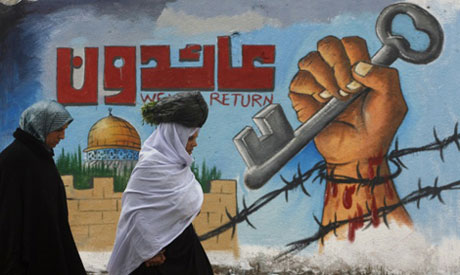
Palestinians walk past a painted wall during a rally marking the upcoming 63rd anniversary of the Nakba, Graffiti painting symbolizes the loss of Palestinian homes in 1948, (AP).
As he does every year on this day, Maged Abu Awad, 22, brings a pile of papers and puts them in front of his grandmother Zayda for her to hold in her hands. Today marks the 63rd anniversary of the Palestinian Nakba, the Arabic word meaning calamity which Palestinians use to refer to their expulsion from Palestine. Although she is blind, this eighty-year old woman insists on holding the documents. They were issued in March 1908 by the Ottoman administration in Beir Sabe, and they confirm her family’s ownership of 1,500 dunams of land inside the city.
The documents she calls kawasheen have yellowed, but the family of Abu Awad still keep them safe. They confirm the family’s ownership of the land before it was taken over by Zionist militias decades ago. What Zayda doesn’t know is that the land documented in the papers has been used to build Jewish settlements. Jewish immigrants from France now live on the land, on which they grow grapes and make wine.
Many Palestinian families still hold on to these kawasheen. They believe that one day they will recover their rights to return to their land. Hassan Ramadan, 79, who now lives in Deir Al-Balah in the centre of the Gaza Strip, says he still remembers every inch of his village of Hamamah in southern Palestine. The village is now the site of Hatzerim, one of Israel’s largest military bases. “I might die before I go back to Hamamah,” Ramadan says, “but I am confident that if my children and grandchildren don’t go back there, their children and grandchildren one day will. These are rights which we will not give up.”
Hassan Al-Emad fled with his family from the village of Barbara on 25 March, 1948, when Zionist militias began shooting randomly at worshippers in the local mosque during midday prayers. Al-Emad, who currently lives at Al-Maghazi Refugee Camp in the centre of Gaza, was only seven years old at the time. Yet he still remembers the bodies of children he once played with loaded with Zionist bullets at the entrance to the village mosque. He has made his five children and 30 grandchildren promise that they will do their best to one day liberate Barbara.
Students in Palestine have special activities at school to mark the anniversary of the Nakba. Ibrahim Borayk, 11, a sixth grader, is planning a surprise for his classmates. He plans to show them the key to the house his grandfather owned in the town of Askalan in southern Palestine. In his speech, Borayk will tell them he plans to hold on to this key and work to take it back to Askalan one day.
This year, the Palestinians whom Zionist militias failed to expel are planning unprecedented activities to mark the Nakba. One is a march by youth to Palestinian villages which Zionist militias destroyed on the eve of the 1948 war. One will head to Al-Damon and Al-Roweis, towns that were destroyed on the eve of the war, their residents expelled to Lebanon.
The Arab Follow-Up Committee, a leadership umbrella that unites the Palestinians who remained in Palestine, will sponsor several activities throughout the week. Among these are drives to renovate cemeteries and mosques that stand amid the rubble of destroyed towns and cities. Palestinian youth are keen to pray every Friday in these renovated mosques, such as the Abu Hussein mosque in the destroyed village of Al-Hassanat, now the tourist town Nof Yam. Over the objections of Jewish settlers there, Sheikh Raed Salah, leader of the Islamic movement in Israel, presides over the youth’s prayer services at the mosque. There is also a plan to renovate all the mosques and Islamic cemeteries which survived the Nakba.
Short link: